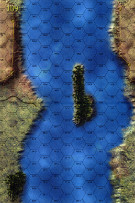|
|
|
Total |
| Side 1 |
1 |
| Draw |
0 |
| Side 2 |
0 |
|
Total |
| Side 1 |
1 |
| Draw |
0 |
| Side 2 |
0 |
|
Total |
| Side 1 |
0 |
| Draw |
0 |
| Side 2 |
0 |
|
| Overall Rating, 1 vote |
|---|
|
|
|
Scenario Rank:
--- of 940 |
| Parent Game |
River Battleships |
| Historicity |
Alt-History |
| Date |
1941-06-01 |
| Start Time |
00:00 |
| Turn Count |
20 |
| Visibility |
Night |
| Counters |
15 |
| Net Morale |
0 |
| Net Initiative |
0 |
| Maps |
1: 109 |
| Layout Dimensions |
43 x 28 cm
17 x 11 in |
| Play Bounty |
158 |
| AAR Bounty |
227 |
| Total Plays |
1 |
| Total AARs |
0 |
|
Introduction
|
|
The former Polish monitors of the “Zhytomyr” type had been salvaged in 1940 and re-armed with Soviet weapons. They formed the core of the Pinsk Flotilla, which also patrolled the upper Dnepr. The Germans did not yet field their improved river gunboats on Russian rivers – dive-bombers proved sufficient – but had their inland fleet been a part of Operation Barbarossa, the Pinsk Flotilla would have stood in their way.
|
|
Conclusion
|
|
The small ex-Polish monitors did not have the staying power of the bigger Soviet or Romanian river craft, but the German “artillery lighters” were essentially motorized barges with a pair of 88mm guns stuck on them. Most rivers in the Soviet Union flowed from north to south, which made them less than useful for an invading enemy, but well-placed to shuttle supplies and reinforcements behind the defender’s front.
|
Display Relevant AFV Rules
| AFV Rules Pertaining to this Scenario's Order of Battle |
- Vulnerable to results on the Assault Combat Chart (7.25, 7.63, ACC), and may be attacked by Anti-Tank fire (11.2, DFT). Anti-Tank fire only affects the individual unit fired upon (7.62, 11.0).
- AFV's are activated by tank leaders (3.2, 3.3, 5.42, 6.8).
They may also be activated as part of an initial activating stack, but if activated in this way would need a tank
leader in order to carry out combat movement.
- AFV's do not block Direct Fire (10.1).
- Full-strength AFV's with "armor efficiency" may make two anti-tank (AT) fire attacks per turn
(either in their action segment or during opportunity fire) if they have AT fire values of 0 or more
(11.2).
- Each unit with an AT fire value of 2 or more may fire at targets at a distance of between 100% and 150% of its
printed AT range. It does so at half its AT fire value. (11.3)
- Efficient and non-efficient AFV's may conduct two opportunity fires per turn if using direct fire
(7.44, 7.64).
Units with both Direct and AT Fire values may use either type of fire in the same turn as their opportunity fire,
but not both (7.22, 13.0).
Units which can take opportunity fire twice per turn do not have to target the same unit both times (13.0).
- Demoralized AFV's are not required to flee from units that do not have AT fire values (14.3).
- Place a Wreck marker when an AFV is eliminated in a bridge or town hex (16.3).
- AFV's do not benefit from Entrenchments (16.42).
- AFV's may Dig In (16.2).
- River Vessels: see Rule 15.2 ~ 15.22
|
Soviet Union Order of Battle


 RiBa008
RiBa008 









